Page Topics
The Best Kitchen Flooring Considerations
Making sure you select the best kitchen flooring that is the right flooring type for your kitchen based on your own specific usage demands, budget and family needs and requirements.
Get this wrong, and your kitchen will look like a nightmare and you’ll end up not adding any value to your home at all.
In fact buyers (if you ever sell) will need to factor in the costs to replace the flooring that you put in. So, basically, what we’re basically saying here is “Get this right!”
Or if you haven’t a clue, get advice. We’ve put together a comparison of the various types of kitchen flooring that you could buy today, hopefully, to help you make the right decision for your home and family.
Your kitchen is one of the key focal points for your home and therefore, it’s critical to get it right from the outset.
You need to take into account your needs in the kitchen, how will it be used, what sort of foot traffic will it get, how easily cleanable would you like it to be?
These factors along with budgetary constraints will all help to determine the most suitable flooring type for your kitchen.
Then to top it all off, you have to them factor in your style and color preferences, assuming they’re available in the flooring product you decide to go with.
Elaborating on some of these considerations mentioned above.
- Your needs – Is your kitchen a place that receives some of the highest foot traffic in your home? Is it a gathering spot for family conversations, or is it simply a place where food is prepared and cooked? Whatever the use of your kitchen, the amount of foot traffic will determine whether or not you need a hard wearing, durable surface, or something less so.
- Ease of cleaning – Depending on your time availability, some floor types are easier to clean and maintain than others. Determine just how important it is to you to have your kitchen floor always looking its best. If you don’t have the time available, or the inclination, then go with something like linoleum, or vinyl for an easy to clean solution. Also be aware that the lighter colored floors, or the natural stone type tiles that have uneven surfaces, whilst looking great, to begin with, can present cleaning difficulties or a consistent cleaning demand over the longer term.
- Budgetary constraints – Its always nice to have an unlimited budget for doing up areas of your home, however for most of us, that isn’t the case. When it comes to spending money on your kitchen floor, don’t go for the cheapest option that you think might meet your needs, go with one that will keep adding value to your home over the longer term. Sure, it may cost a little more in the short term, but the long-term benefits will have it paid for itself many times over.
- Color, and Style – This decision is critical. You need to take into account the overall theme, style, and color of the interior décor of your home. Don’t get too radical in your style and color choices for your kitchen floor. It needs to co-ordinate and blend with the overall feel of your home. So be conservative in your color choices and ensure that whatever color you do decide on, that it compliments and adds to the overall décor of your home.
What types of flooring are available for your new kitchen?
There are a lot of flooring choices for your new kitchen.
So first we’ll highlight to you the basic types of flooring you can choose from and then we’ll elaborate a little more on what their strengths and weaknesses are, to enable you to make an informed decision about what floor type is likely to be best for your kitchen and your own situation;
- Ceramic Tiles
- Granite tiles, slate tiles, or other natural stone
- Solid Hardwood floors
- Laminate Flooring
- Vinyl
- Cork
- Linoleum
- Concrete
- Bamboo
Ceramic Tile
The most common flooring type you’ll see in many homes and one that has been around for ages are your good old ceramic tile which provides a real safe bet for your kitchen floor, and one that will also span most budget ranges.
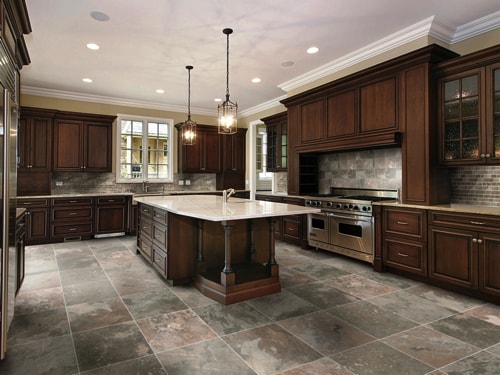
The options for choice here are endless. If your budget is low, you’ll find something that will fit your kitchen plans.
If your budget is high, you will too. Although it’s not uncommon for some homeowners with extreme budgets to go on a tour (holiday) to Italy and hand select their very own tiles to import.
There are always lots of outlets, and wholesalers that run sales and sellouts all the time, so do your best to keep a lookout for massive in-store reductions off the retail price for a decent order.
You will have to choose from the variety of colors available, the size, the shape and even some that have a pattern.
Selecting the right tile for your kitchen will depend on your kitchen style, whether you’re after the contemporary modern look, or the more traditional, classic style look.
Either way, you’ll need to know to have some idea of your color theme, so you don’t choose a tile that would be inappropriate on your floor.
We Like:
Ceramic tiles are extremely hard wearing and will withstand lots of wear and tear. It won’t matter if you traipse mud and dirt into your kitchen and on to your ceramic floor, because cleaning it is a breeze.
Likewise, any spillages or other accidents that happen from time to time will have little or no impact on your flooring.
The value of ceramic tiles as a flooring make it possibly the most cost-effective flooring type for budget seekers, and if you’re the adventurous type, then you could even experiment with creating your own unique tile floor pattern.
We Don’t Like:
Ceramic tiles are unforgiving. When you drop a breakable plate or a glass on to it, it will break 99% of the time.
Likewise, if you lay the tiles on a concrete floor, the lack of flexibility, and the natural movement that occurs in properties over time can cause a tile to crack, and/or the same for grouting, which incidentally, also needs regular cleaning and sealing to maintain a consistent color throughout.
There is often also a cold feeling when walking on a ceramic tile floor barefoot, and there is also the risk of slips when walking on a wet ceramic tile floor.
Costings:
These will vary wildly, but you are likely to be looking at upwards of $3 per square foot (uninstalled)
Natural Stone
Natural Stone, regardless of what type of material they have the major advantage in their natural variation of colors.
It’s true that with natural stone you won’t generally find any two pieces with the same textures, patterns or colors and hence in your home on the floor, it adds a dimension that no other flooring product can provide.
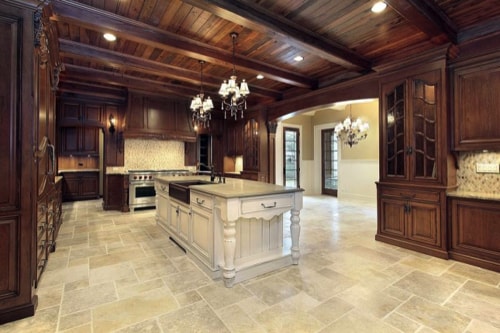
Natural stone is often thought of as either limestone, granite, slate, and travertine.
When using natural stone on a kitchen floor, it does tend to create a rich and elegant look that can instantly lift a kitchen’s perceptible value.
We Like:
Stone floors have built-in natural beauty and because they have been used as a flooring surface for centuries, they have proven to be durable and hard wearing and also require very little maintenance and upkeep.
Like tiles and concrete, they are also cold underfoot which is great for people living in hotter climes.
We Don’t Like:
Stone, being a natural product can be expensive and is not ideally suited for the do-it-yourself type. It is notorious for trapping dirt and depending on the softness of the stone, it can become scratched and chipped.
It may even require regular sealing of the surface to add protection if it is of a porous type.
Costings:
Again some wild variability in pricing, but you can expect to pay around $15 to $30 per square foot, uninstalled.
Solid Timber
There is nothing more naturally beautiful than the warmth and beauty of a real solid wood floor.
With kitchens being places of high foot traffic and high moisture, the choice of a wooden floor can be a good one for longevity and a date-less look.
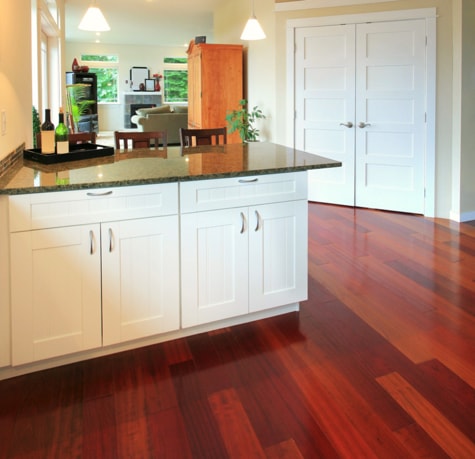 The caveat here is that the composite flooring materials and the manufactured laminated or synthetic timber look products are not a suitable choice for a kitchen floor.
The caveat here is that the composite flooring materials and the manufactured laminated or synthetic timber look products are not a suitable choice for a kitchen floor.
For this example, we are referring exclusively to ‘solid hardwood flooring’ materials.
When cared for, and treated appropriately, they can last indefinitely.
We Like:
Solid wood planks in whatever material or timber type you choose, will provide you with plenty of choices to do with color and look.
Whether you want a light wood, a dark wood, or a heavily grained wood, there should be a solid wooden floor type to fit your needs, and because its timeless in its look, with a little regular maintenance of sanding and refinishing, you can maintain its great look for many years.
We Don’t Like:
Dents and scratches are the enemies of the timber floor.
When you drop solid objects, they can leave permanent marks in the floor (usually until they are removed by sanding and refinishing) Also any liquid spillages, require prompt cleaning up to avoid damage to the surface.
Costings:
Timber flooring will cost between about $5 and $12 per square foot, uninstalled.
Vinyl
Vinyl seems to have been around for years as a flooring choice and it was also primarily chosen based on price.
The range of choices was always relatively limited and it was never quite a choice that would give your kitchen the fashion edge.
We Like:
 Still, a relatively cheap kitchen flooring option compared with other choices, you can now have the look of other more expensive materials at a fraction of the cost.
Still, a relatively cheap kitchen flooring option compared with other choices, you can now have the look of other more expensive materials at a fraction of the cost.
Vinyl floors are easy to clean and maintain, and it’s a relatively simple process to patch an area that may have been damaged.
It generally offers a comfortable underfoot feeling and is relatively simple for the DIY’er to install.
Vinyl is a great choice of kitchen flooring for lower value homes, or rental houses, or infrequently used holiday homes.
We Don’t Like:
Vinyl is prone to denting, bubbling and lifting and can even curl up at the edges over time. It can be easily subjected to tearing, or surface damage from dirt and grit which is not repairable unless you patch the damaged area and it is also possible that the look can fade in strong sunlight.
Whilst it is a cheaper option when compared to other flooring choices, the long-term lifespan of a vinyl floor is somewhat limited. You will probably begin to notice obvious signs of wear and tear after about 4 or 5 years.
Costings:
If you shop around, you can probably source some good vinyl options for between $2 to $20 per square foot, uninstalled.
Linoleum
You might be thinking ‘but you just did vinyl, why are you now covering linoleum?’
It’s not uncommon for people to confuse vinyl and linoleum, but the reality is they are completely different products.
Linoleum has been around for quite a long time, originally being developed back in the 1800’s and has sold extensively in either sheets or tiles and is available in a wide variety of colors.
Installing linoleum should be done by a professional installer as almost all practical applications of linoleum is likely to require extensive seams and its wearability over time will likely be based on the base over which it installed.
Linoleum was developed from all natural materials, such as linseed oil, resins, wood flour and the like, however as synthetic flooring started to become popular, it became unfashionable.
Nevertheless, due to its ‘green-ness’ and the fact that ‘retro’ is making a fashionable comeback, the use of linoleum is again on the rise making it a perfect option for people with classically styled cottages or those looking to recreate that mid-twentieth century interior look.
We Like:
Linoleum is a versatile product. Since it is available in practically every color imaginable, it gives great flexibility to the kitchen owner, especially those looking for the boldness of color on the floor.
We Don’t Like:
Linoleum is a product that can wear and fade in time and with lots of use. Some manufacturers choose to add a protective surface coating before it is sold.
If you look to buy linoleum without such a coating, then you are likely to need to periodically wax and polish the floor. It can expensive to install, and is potentially difficult to work with, hence the need for a professional linoleum installer, and these people can also be difficult to find
Cost:
About $5 to $8 per square foot, uninstalled. Custom colors and patterns add to the price tag.
Concrete
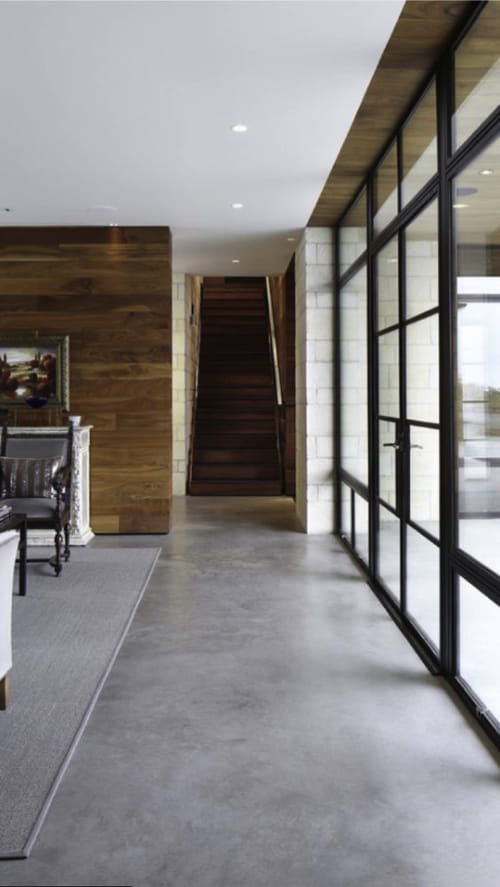
Concrete flooring (as you can no doubt imagine) is probably the hardest and most durable of flooring surfaces.
It has ventured a long way since days of old, when it was only ever on a basement or garage floors, or hidden beneath carpeting or some other softer feeling covering.
Many recent designers have taken concrete under their wings due to its versatility and applied a multitude of personalization aspects to it.
Polishing the concrete provides a beautiful finish that would match the look of many other hard surface finishes.
Colorings or stains are added to provide uniqueness in the final look.
Other ways concrete is treated to provide a unique flooring surface is through surface techniques like acid etching, scoring, or even stamping with interesting or unique designs and styles.
We Like:
Concrete is renown for its ability to remain cool, even in the hottest of weather, making it great for hotter climate areas.
Dollar for dollar it offers the best value when it comes to durability being practically indestructible, it will end up looking just as good after its cleaned up (Assuming it was sealed, to begin with).
Also, should you ever tire of the semi-industrial look of concrete, you can always cover with an alternative flooring surface.
We Don’t Like:
Concrete flooring (as a finished surface) requires professional installation.
It can feel solid to the underfoot and doesn’t have the give of many other flooring types like hardwood.
Being porous, it means you’ll need to seal the surface to prevent stains, especially in the high traffic areas like the kitchen where spillages and droppages are commonplace.
Not an ideal surface for the colder climates if you desire a warm looking and feeling surface.
Cost:
 The costs of pouring a concrete floor can vary wildly.
The costs of pouring a concrete floor can vary wildly.
Depending on the overall complexity, concrete floors can cost as little as $2 to $6 a square foot or as much as $15 to $30 a square foot.
Typically, a decorative concrete floor installation will be quite cost-effective, especially if you already have an existing concrete slab that’s ready for staining, polishing or an application of a decorative coating or overlay.
Concrete finishing treatments, such as staining, stamping or etching are likely to range between about $2 per square foot and $15 or more per square foot.
Cork
Cork is a naturally grown product from the bark of a tree and has become particularly popular of late as a kitchen floor material.
One of the recent innovations with cork is that it is now available in a variety of patterns and colors.
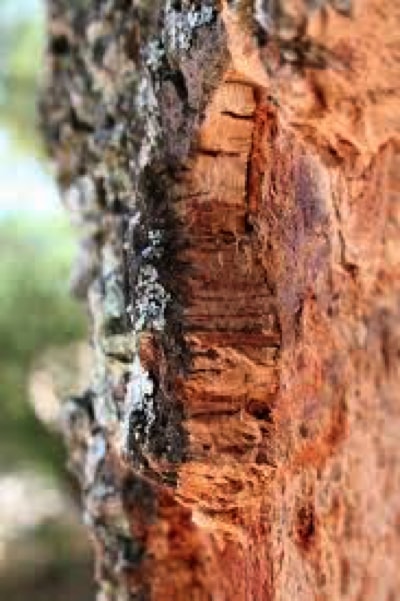 For people that like a soft feel underfoot will like a cork kitchen floor.
For people that like a soft feel underfoot will like a cork kitchen floor.
With it natural air pockets, it provides a softness or spongy feeling that many other floor surfaces don’t.
An eco-friendly product, the look of cork on a kitchen floor isn’t for everyone.
It can be a practical floor for cooks or chefs that spend long hours standing, but aesthetically, it is a floor type you either like or loathe.
We Like:
A flexible product that is most often laid in tile forms.
A natural shock absorber, it provides great underfoot comfort and is more forgiving when glasses or crockery are dropped onto it.
It holds the warmth and is also a great sound absorber.
Because of its makeup, it is also naturally resistant to mold or mildew.
We Don’t Like:
If exposed to grit, or dirt, it can become scarred or easily marked, hence regular cleaning is required.
Cork must also be regularly sealed with polyurethane.
Generally, self-forgiving to hard items dropped onto creating small dents or marks, major damage would often require the replacement of a tile. It pays to keep some spares when first installing cork.
Also, it can be prone to fading over time.
Cost:
General costs for cork will be about $2 to $12 per square foot, uninstalled depending on what you select, although the average often works out around $6-$8 per square foot.
Laminate
Constructed of four layers of material fused together: a melamine wear layer, a high-resolution photo, a dense core board, and a melamine backing layer, a laminate flooring surface is ideal for people who want a particular ‘look’, but either don’t have the budget to extend to the ‘real thing’, or want less maintenance.
Laminate floors require specifically designed underlayment to serve as a moisture barrier and muffle sound, but it can even make a laminate floor sound more like hardwood when walked on.
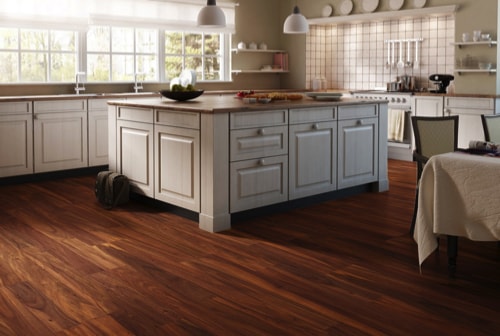
Kitchens that have frequent spillages, or kids and pet traffic will suit the durable surface a laminate floor can provide.
A laminate floor is often made to look like hardwood or tile, and it also often comes at a lower price.
The surface is usually resistant to stains and marks and is simple and easy to clean up.
Unlike the original hardwood floors upon which its looks are often based, it doesn’t get better with age, and its unable to be sanded.
However, visually, when it comes to some of the better options available today, it can be a challenge to distinguish a high-end laminate from the real thing.
We Like:
A laminate floor looks good and requires very little maintenance, usually just a sweep and a damp mop. Some versions of laminate flooring make it easy for a DIY installation. Costs generally are moderate.
We Don’t Like:
Even though ti can look like the real thing, if it starts showing its age, it has to be replaced completely. It doesn’t give the depth, or texture of the original product that it is based on, and it has a much shorter lifespan than its counterpart as well.
Cost:
About $2 to $4 uninstalled, but for a typically average house, you could expect to pay between $5 to $8 per square foot, installed.
Bamboo
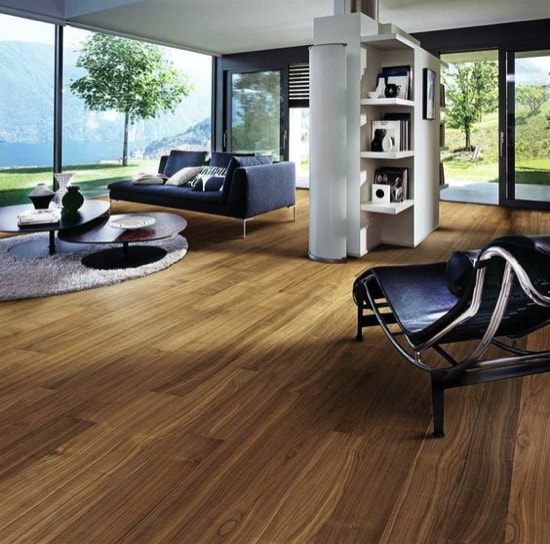
Bamboo flooring is actually a type of grass that gives the appearance and look of a hardwood floor. Bamboo is such a hardy plant, and bamboo flooring is no different.
Quite a dense product, it will withstand a busy active family lifestyle in a kitchen.
However, being a natural product, and like any hardwood floor, the same care needs to be applied in regards to preventing scratches and dents from accidents.
The subfloor for bamboo must be super smooth otherwise the bamboo floor is likely to show the imperfections.
Bamboo is susceptible to moisture and so its vital a waterproof underlay be installed on top of a concrete slab.
Bamboo is able to be laid in horizontal strips laid flat which shows off the rich grains of the bamboo.
It can be woven or stranded (This is the hardest) whereby the shredded bamboo is compressed with a resin creating an exotic and stunning look.
A vertical style which features the strips turned sideways provides a very modern look.
Naturally a blonde color, the material is able to be stained different colors or pressure heat treated which caramelizes the bamboo’s sugar content to produce a natural warm brown color.
We Like:
Due to its rapid growth, it is a sustainable flooring product for green building choices.
It contains most of the benefits of a hardwood floor such as low maintenance, and great look, but bamboo also provides a much more gentler underfoot experience than the hardwoods. It also works out a little cheaper than its hardwood counterpart.
We Don’t Like:
Limited range of color choices when compared with other woods. It can warp in high humidity environments, so may not be suitable for all situations. Quality control needs to be paramount when choosing bamboo flooring, since most of it is imported, and the quality of the product can vary
Cost:
Expect to pay around $4 to $9 per square foot, uninstalled.


